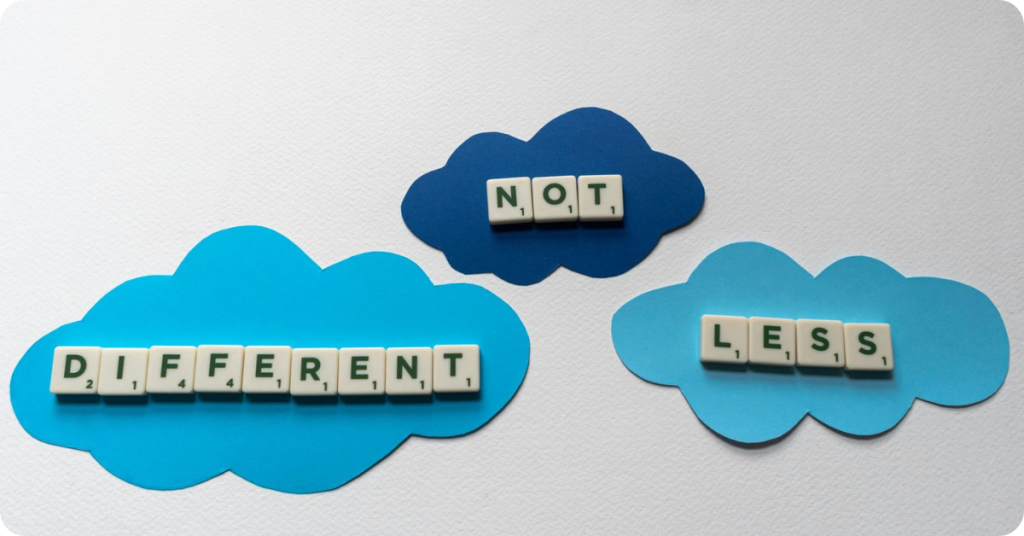How to support neurodiversity in your tech team
-
 Morgane Oléron
Morgane Oléron

We’re all different. That is something we know and hear throughout our lives. However, when it comes to the workforce, we are often expected to adapt to a “one size fits all” environment and set-up—something that might work for a majority but is challenging for others.
These people bring their skills and talents and should be welcomed in the workforce, even if it means adapting to their needs.
Understanding Neurodiversity
Neurodiversity refers to the fact that our brains can work differently. Some people process things faster or in a different way than others. Some find it easy to do certain things while others struggle, but these same people might succeed in areas where the first ones fail.
The way it is mainly used nowadays (the term appeared in the mainstream world around the 1990s) is to refer to people who are considered “on the spectrum” or suffering from disorders such as ADHD or Autism.
Neurodivergent employees, particularly those with ADHD, often exhibit distinct communication and behavioural patterns in team settings. Recognizing these traits and responding appropriately requires a nuanced approach to avoid misinterpretation while fostering inclusivity.
Society tends to consider any difference a problem and something to fix. It is not rare for companies to assume that neurodivergent people cannot work. Many platforms are now working hard to fight those stigmas and improve inclusivity for neurodivergent employees.
People on the autism spectrum, people with ADHD, but also epileptic people, or those who have dyslexia are all considered neurodivergent.
The first thing to understand is how diverse the types of neurodivergence are.
These people are more often than not fully capable of working and delivering within a team and company if only they could benefit from some adjustments.

Benefits of Neurodiversity in Tech
Neurodivergent employees bring their specific skills to the mix. Because their brains function differently from what is considered “the norm,” they provide a different approach to addressing an issue or a challenge. They can also have strong analytical skills and specific attention to detail. These skills help enhance innovation, increase accuracy, and eventually bring a competitive edge to the company.
Like everything else, the fear of the unknown often blocks employers from hiring neurodivergent employees, assuming it would demand a lot of complicated adjustments. In reality, simple steps can be taken that will benefit all employees and the company in the long run.
They provide a different approach to addressing an issue or a challenge
Recognizing Neurodivergent Traits in Team Settings
Neurodivergent employees can exhibit specific ways of working and communicating that can be misunderstood and misinterpreted. Managers need to recognize these traits and learn how to approach these situations appropriately.
Indeed, people with ADHD or autism may display some or several of the following behaviours:
- Inconsistent focus: between routine and specific tasks.
- Impulsive communication: quick change of topics or interrupting conversations.
- Sensory sensitivities: overwhelmed by their environment (lights, sounds…).
- Time management challenges: Missing deadlines despite effort…
That being said, some people who have no diagnosis of neurodivergence can also display similar traits. That is why it should not automatically be assumed that everyone with time management challenges or sensory sensitivities is neurodivergent.
Avoiding Misinterpretations
Suppose these traits are identified in an employee instead of immediately concluding that the individual is conflictual or disengaged. In that case, the manager should try to avoid assumptions from bias that would lead them to attribute these actions to a lack of professionalism, respect or even laziness. Instead, they should look for patterns and observe whether behaviours are situational (e.g., occurring only in noisy settings) or consistent, for example.
While some employees will share their diagnoses, some might not wish to disclose their neurodivergence or might not be diagnosed yet.
It is essential to create an environment where everyone can thrive.
Creating a Neuro-inclusive Tech Environment
Here are simple yet essential things to consider.
1. Flexible Work Arrangements
This is something often mentioned for any type of employee, neurodivergent or not, as a way to increase well-being and mental health. It includes remote work, flexible hours, asynchronous tools, or a four-day workweek.
It also helps neurodivergent employees with issues regarding schedules, crowded places, commuting in public transport, and communicating face-to-face or in public.
2. Clear Communication
Clear communication at work is key. This is true for everyone, but even more so for neurodivergent employees.
In addition to giving instructions face to face, it is recommended to:
- Providing written instructions to support the verbal ones is often recommended.
- Make use of tools and apps for asynchronous communication.
- Give clear and direct feedback.
- Use visual tracking software management.

3. Sensory-friendly Workspace
A seemingly typical workspace can be filled with sensory stimuli that can be very distracting and create a sensory overload for neurodivergent people. There are easy things that can be implemented to remedy these challenges:
- Provide noise-cancelling headphones.
- Have dimmer switches or desk lamps, allowing employees to adjust the lighting.
- Create different areas for different activities.
- Minimize strong smells in the office.
4. Tailored Recruitment and Hiring Processes
Because of stigma or a lack of awareness about these conditions, recruiting neurodivergent candidates is not always seamless. Every company need to look at their hiring practices and adapt them to be more inclusive by:
- Partnering with organizations specializing in neurodiversity hiring.
- Using alternative assessment methods that focus on skills rather than traditional interview techniques.
- Offering mentorship programs and regular check-ins for neurodivergent employees.
- Asking about the employee’s needs and how you can work together to make their environment more suitable.
5. Education and Awareness
As mentioned, there are many reasons why bringing in neurodivergent colleagues can be perceived as complicated, from “simple” discrimination and stigma to a lack of education on the topic.
It is essential to foster understanding and acceptance within the team early on by providing training, encouraging open discussions, and celebrating diverse approaches in the company’s day-to-day business.
Training managers is crucial for creating an inclusive workspace:
- Organizing regular mandatory training around neurodiversity, what language to use, how to best communicate, and learning more about the neurodifferences and legal aspects.
- Offering ongoing support to your teams and managers to navigate certain situations.

Embracing differences in the workplace can lead to personal and professional growth for individuals and the business. However, it demands being open-minded and ready to make adjustments, whether in interior design or education, so that every employee feels included and accepted.
Want to know more about how Siffi is helping organisations? Check out our services
About the author

Morgane Oléron
Mental wellbeing content writer at Siffi
Morgane crafts compassionate, engaging content that makes mental health conversations more human and accessible. At Siffi, she combines storytelling with strategy to foster a culture of care and connection in the workplace.
Recent Posts
Newsletter
Sign up for our newsletter and get monthly tips and tricks for better mental well-being from our certified therapists and coaches.